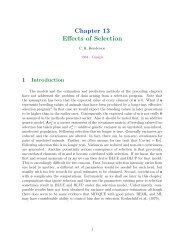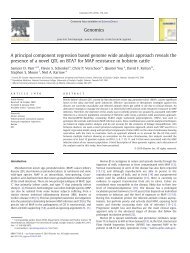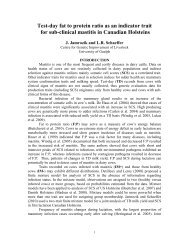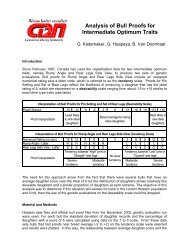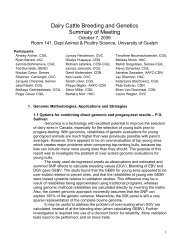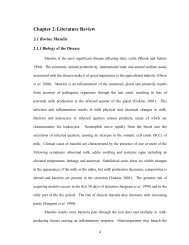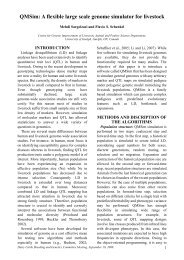Estimation of additive and dominance genetic variances for - CGIL ...
Estimation of additive and dominance genetic variances for - CGIL ...
Estimation of additive and dominance genetic variances for - CGIL ...
You also want an ePaper? Increase the reach of your titles
YUMPU automatically turns print PDFs into web optimized ePapers that Google loves.
( )<br />
M.J.R. Pante et al.rAquaculture 204 2002 383–392 385<br />
important source <strong>of</strong> <strong>genetic</strong> variation <strong>for</strong> some growth traits in fish. There<strong>for</strong>e, the<br />
purpose <strong>of</strong> this study was to determine the magnitude <strong>of</strong> <strong>additive</strong> <strong>and</strong> <strong>dominance</strong> <strong>genetic</strong><br />
<strong>variances</strong> <strong>for</strong> body weight at harvest <strong>of</strong> rainbow trout <strong>and</strong> the common environmental<br />
effect due to full-sib groups.<br />
2. Materials <strong>and</strong> methods<br />
Data were from three rainbow trout populations under selection <strong>for</strong> six generations<br />
at the Aqua Gen AS in Norway from 1972 to 1992. Each population was established<br />
separately in a different year Ž Table 1 . . The founding individuals <strong>for</strong> each population<br />
were from different fish farms in Norway <strong>and</strong> Sweden <strong>and</strong> thus were assumed to be<br />
from different gene pools. The pedigree data comprised seven generations Žgenerations<br />
0–6 . . Individual growth was measured as body weight Ž kg. at harvest recorded after<br />
16–18 months <strong>of</strong> rearing in floating net cages in the sea.<br />
The data analyzed were from generations 2–6 <strong>for</strong> all three populations <strong>and</strong> comprise<br />
a total <strong>of</strong> 15 year-classes Ž Table 1. <strong>and</strong> with a data structure as presented in Table 2. The<br />
fish were <strong>of</strong>fspring <strong>of</strong> broodstock selected mainly <strong>for</strong> fast growth rate, <strong>and</strong> the selection<br />
method practiced was a combination <strong>of</strong> between-family <strong>and</strong> within-family selection. A<br />
hierarchical mating design was applied where each sire is mated on average to two to<br />
three dams. In all generations, full- <strong>and</strong> half-sib matings were avoided <strong>and</strong> matings that<br />
would yield inbreeding coefficients <strong>of</strong> 12.5% or higher were restricted. Marking <strong>of</strong><br />
newly hatched larvae or fry is impossible; thus, each full-sib family was reared in<br />
separate tanks until reaching the average tagging size <strong>of</strong> 20 g. This introduces an<br />
environmental effect common to full-sib groups. To identify the families, a combination<br />
<strong>of</strong> fin clipping <strong>and</strong> freeze-br<strong>and</strong>ing was used Ž Gunnes <strong>and</strong> Refstie, 1980 . . The individuals<br />
selected as parents <strong>for</strong> the next generation were individually marked with operculum<br />
tags.<br />
Variance components <strong>for</strong> body weight at harvest were estimated <strong>for</strong> different effects<br />
fitted to a single trait animal model using the AIREMLF90 program ŽTsuruta<br />
<strong>and</strong><br />
Misztal, 2000 . . The algorithm uses the Average In<strong>for</strong>mation Ž AI. as second differentials<br />
Table 1<br />
The three separate populations analyzed in the study <strong>and</strong> the year-classes representing the time <strong>of</strong> hatching in<br />
each population<br />
Generation Population 1 Population 2 Population 3<br />
0 1972 1973 1974<br />
a 1 1975 1976 1977<br />
2 1978 1979 1980<br />
3 1981 1982 1983<br />
4 1984 1985 1986<br />
5 1987 1988 1989<br />
6 1990 1991 1992<br />
a The first generation where <strong>of</strong>fspring were selected <strong>for</strong> fast growth rate.





